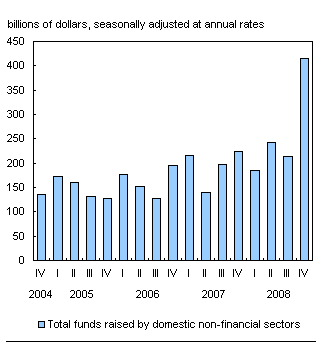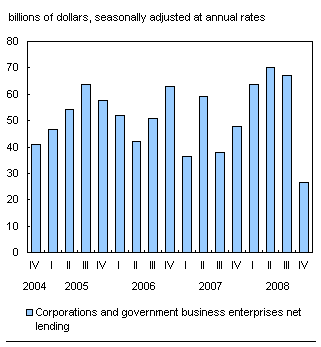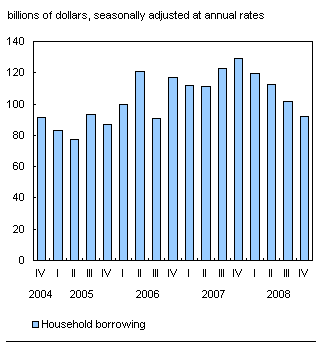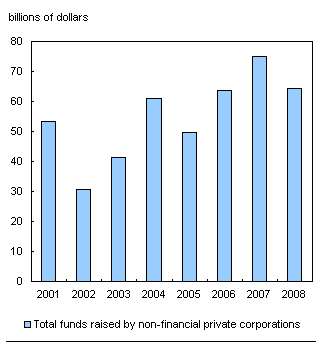Common menu bar links
Financial flows
Archived Content
Information identified as archived is provided for reference, research or recordkeeping purposes. It is not subject to the Government of Canada Web Standards and has not been altered or updated since it was archived. Please "contact us" to request a format other than those available.
Fourth quarter 2008
Financial flows note to readers
Overview
Funds borrowed on financial markets by domestic non-financial sectors increased in the fourth quarter of 2008, to $416 billion (seasonally adjusted at annual rates).
Federal government short-term paper and bond issues accounted for more than 50% of total activity. This was led by a record quarterly issuance of treasury bills, partly in support of the federal government's Insured Mortgage Purchase Program.
Chart E.1 Demand for funds accelerates

Canadian stock exchanges were down again in the fourth quarter. The resource laden S&P Toronto Stock Exchange composite index, fell 24%, its largest percentage decline in a decade. The continued fall in commodity prices and demand for energy products did little to support the domestic currency. The Canadian dollar depreciated by 14% in the quarter relative to its US counterpart.
The Bank of Canada's key trend setting rate, the bank rate was reduced by more than 150 basis points, closing out the quarter at 1.75%. Cuts in the United States were more pronounced during the quarter, as the Federal Reserve funds rate fell to an all-time low of 0.10%.
Government sector
Overall government borrowing increased seven-fold between the third and fourth quarter of 2008. For the first time since the third quarter of 2003, the government sector became a net borrower from the rest of the economy.
The Federal government raised $227 billion in the fourth quarter (these are expressed at seasonally adjusted annual rates; on a quarterly basis the government raised $57 billion). About half of this borrowing was linked to the Insured Mortgage Purchase Program, which provided liquidity to Canadian financial markets through the Canada Mortgage and Housing Corporation (CMHC). Treasury bill issues met market demand for liquid investments and also provided funds that were deposited at the Bank of Canada to support its efforts in supporting Canadian financial markets.
Borrowing by other levels of government also picked up during the quarter, reflecting a return to deficit positions (on a national accounts basis) at the provincial and local government levels.
Financial institutions adjust their financial positions
The Bank of Canada provided significant liquidity during the quarter through the increased use of purchase and resale agreements with financial institutions.
Institutional investors reduced their foreign investments in exchange for short-term paper and domestic bonds. Lending institutions also invested heavily in domestic fixed income securities while net new loan issuances slowed. The fourth quarter of 2008 marked the largest ever issuance of National Housing Act - Mortgage Backed-Securities, with CMHC acquiring about half under the Insured Mortgage Purchase Program.
Corporate profits declined 20% in the fourth quarter. Savings of non-financial corporations, previously buoyed by high commodity prices, retreated significantly. As a result, the non-financial corporate sector moved into a deficit position, their largest since the fourth quarter of 1999.
Non-financial corporations' new borrowings included a substantial increase in bank loans, as there was a significant drop in activity in both the bond and equity markets.
Chart E.2 Corporate sector surplus drops off significantly

Household sector
Overall household borrowing slowed to $92 billion during the fourth quarter of 2008, led by dampened growth in consumer credit and mortgages. Net new mortgage borrowing was down more than 6% in the quarter, with decreased activity in the resale housing market.
Chart E.3 Household borrowing slows

Consumer credit flows were significantly lower in the fourth quarter of 2008, posting their largest quarterly percentage drop in over a decade. Despite this recent slowdown, borrowing has remained at high levels since late 2007. Personal expenditure fell during the quarter with notable declines in new and used motor vehicles.
Year-end review 2008
For the year as a whole, total funds raised in 2008 were up over one-third compared to 2007.
The government sector borrowed heavily in 2008, led principally by the federal government. After 2 years of net reductions in credit market debt, the federal government sharply increased issues of short-term paper and bonds. This activity was concentrated in the fourth quarter, in response to rapidly deteriorating credit and equity conditions.
Chart E.4 Overall demand for funds slows

Private non-financial corporations relied increasingly on loans as method of finance, as the year progressed, rather than equity and bond issuance.
Flow of funds to the persons and unincorporated business sector slowed in 2008, the first deceleration in 12 years. This was the result of successive quarterly slowdowns in mortgage and consumer credit borrowing in 2008. This occurred as residential investment was down and personal expenditures on consumer goods and services, notably durables, slowed.
Data tables
- Table E.1 Financial market summary table
- Table E.2 Sector accounts - Persons and unincorporated businesses
- Table E.3 Sector accounts - Corporations and government business enterprises: Total
- Table E.4 Sector accounts - Government
- Table E.5 Sector accounts - Non-residents
Information on methods and data quality available in the Integrated Meta Data Base: 1804.

